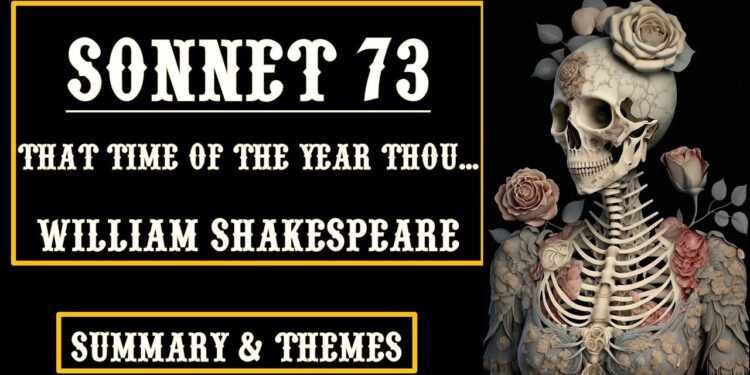Introduction to Sonnet 73
Poem Sonnet 73 By William Shakespeare Summary William Shakespeare’s Sonnet 73 is part of his collection of 154 sonnets, which explore themes of love, time, beauty, and mortality. Written in the form of a traditional Shakespearean sonnet, it consists of 14 lines structured into three quatrains followed by a final rhymed couplet. Sonnet 73 is particularly notable for its poignant exploration of aging and the passage of time, using vivid imagery to convey the speaker’s feelings toward the inevitable decline of life and the impact of mortality on love.
Summary of Sonnet 73
Quatrain 1: The Imagery of Autumn
The poem opens with the speaker addressing a beloved, suggesting that this person can see the evidence of the speaker’s aging. The first quatrain establishes the metaphor of the autumn season, with “yellow leaves” symbolizing decay and decline. The imagery of “few do hang” on the branches conveys a sense of desolation, as the leaves have mostly fallen. The reference to “bare ruined choirs” evokes the idea of a once vibrant and lively space now left empty, much like the speaker’s life as they approach death.
The choice of “choirs” has a dual significance. It not only refers to the literal choirs that have fallen silent, suggesting the absence of music and life, but it also hints at the spiritual or religious connotations associated with choirs, reflecting a loss of vitality and connection to the divine. The phrase “where late the sweet birds sang” underscores the contrast between past vibrancy and present desolation, amplifying the sense of loss.Poem Sonnet 73 By William Shakespeare Summary

Quatrain 2: The Twilight of Life
In the second quatrain, the speaker continues the theme of twilight, using it as a metaphor for old age. “In me thou seest the twilight of such day” suggests a transition from life to death, with twilight symbolizing the diminishing of light and vitality. The image of a sunset fading in the west indicates that the speaker’s life is nearing its end, further underscored by the phrase “black night doth take away.”
“Death’s second self” refers to sleep, which is often associated with death in literature. It implies that sleep is a temporary state, but in this context, it foreshadows the eternal rest that death brings. The speaker’s acknowledgment of aging and mortality invites the beloved to reflect on the fleeting nature of life.
Quatrain 3: The Dying Fire
Poem Sonnet 73 By William Shakespeare Summary The third quatrain shifts to the imagery of fire, where the speaker compares his aging body to a fire that has burned low. The “glowing of such fire” suggests that while there is still some warmth and life left, it is overshadowed by the “ashes of his youth.” The metaphor of the fire on its deathbed illustrates the gradual fading of life force, emphasizing that the speaker is nearing the end of his existence.
The line “consumed with that which it was nourished by” suggests a cyclical nature of life—youth (which nurtured the fire) has led to its decline, demonstrating how the very essence of life can lead to its end. This imagery poignantly captures the paradox of aging: the vitality that once fueled life ultimately contributes to its exhaustion.Poem Sonnet 73 By William Shakespeare Summary
Couplet: The Strength of Love in Acknowledgment of Mortality
The final couplet serves as a culmination of the themes presented in the previous quatrains. The speaker recognizes that this acknowledgment of mortality strengthens the beloved’s love: “This thou perceivest, which makes thy love more strong.” Understanding the transient nature of life enhances the depth of their relationship, suggesting that love is intensified when confronted with the reality of loss.Poem Sonnet 73 By William Shakespeare Summary
Poem Sonnet 73 By William Shakespeare Summary The phrase “to love that well which thou must leave ere long” underscores the urgency of love in the face of impending separation. The beloved’s awareness of the speaker’s aging instills a sense of appreciation for their time together, acknowledging that love becomes more precious when it is finite.

Themes in Sonnet 73
1. The Passage of Time
The most prominent theme in Sonnet 73 is the passage of time and its effects on the human condition. Shakespeare masterfully conveys how time transforms life, leading to aging and mortality. The metaphors of autumn, twilight, and dying fire reflect different aspects of the natural cycle of life, emphasizing the inevitability of decline and death.Poem Sonnet 73 By William Shakespeare Summary
2. Love and Mortality
Another significant theme is the relationship between love and mortality. The speaker suggests that awareness of death enhances the value of love. In the face of impending loss, love takes on greater significance, urging individuals to cherish their connections while they can. This interplay between love and mortality is a recurring motif in Shakespeare’s work, highlighting the emotional depth of human relationships.
3. Nature and Transience
Shakespeare draws heavily on natural imagery to illustrate the themes of transience and decay. The changing seasons, particularly autumn, serve as powerful symbols of life’s fleeting nature. The use of nature to reflect human emotions and experiences reinforces the idea that life is a continuous cycle of growth, decay, and renewal.
4. Identity and Self-Reflection
Poem Sonnet 73 By William Shakespeare Summary Sonnet 73 also delves into themes of identity and self-reflection. The speaker confronts his own aging and mortality, prompting an introspective examination of his life and relationships. This self-awareness fosters a deeper understanding of love, urging both the speaker and the beloved to appreciate the present moment.
READ MORE
Analysis of Language and Form
Sonnet Structure
Poem Sonnet 73 By William Shakespeare Summary Sonnet 73 follows the traditional Shakespearean sonnet form, consisting of three quatrains and a final couplet. This structure allows for a clear progression of ideas, with each quatrain building upon the previous one before culminating in the impactful couplet. The rhyme scheme (ABABCDCDEFEFGG) contributes to the lyrical quality of the poem, enhancing its emotional resonance.
Imagery and Symbolism
Shakespeare employs rich imagery and symbolism throughout Sonnet 73 to convey complex themes. The use of natural imagery (autumn leaves, twilight, fire) creates a vivid backdrop against which the speaker’s reflections on aging and mortality unfold. Each image serves to evoke specific emotions and convey the gravity of the speaker’s situation.
- Autumn: Represents aging and decline.
- Twilight: Symbolizes the transition from life to death.
- Fire: Illustrates the vitality of youth and its inevitable fading.
Sound and Rhythm
Poem Sonnet 73 By William Shakespeare Summary The poem’s rhythm, characterized by iambic pentameter, contributes to its musicality. The natural flow of the language mirrors the themes of time and aging, creating a sense of movement that reflects the passage of life. The careful choice of words and sounds enhances the emotional impact of the poem, drawing readers into the speaker’s contemplations.
Interpretations and Critiques
Scholars and literary critics have offered various interpretations of Sonnet 73, emphasizing its exploration of love, mortality, and the human experience. Some interpretations highlight the poem’s philosophical underpinnings, examining how the awareness of mortality shapes human relationships. Others focus on the emotional depth conveyed through the speaker’s reflections, considering the personal nature of the poem as a meditation on aging.Poem Sonnet 73 By William Shakespeare Summary
The nuanced portrayal of love in the face of mortality has led to discussions about the nature of affection and the ways it is intensified by the knowledge of loss. The poem invites readers to reflect on their own experiences with aging, love, and the passage of time, making it universally relatable.
Conclusion
In conclusion, Shakespeare’s Sonnet 73 stands as a powerful meditation on aging, love, and the transience of life. Through rich imagery, careful structure, and profound themes, the poem captures the complexities of human emotions in the face of mortality. The interplay between love and death serves to deepen the connection between the speaker and the beloved, illustrating how awareness of life’s impermanence can enhance the value of love.
Poem Sonnet 73 By William Shakespeare Summary Sonnet 73 remains a timeless piece of literature, resonating with readers across generations as it prompts reflections on the nature of existence, the inevitability of change, and the enduring power of love.
(FAQ)
Q1: What is the main theme of Sonnet 73?
The main theme of Sonnet 73 is the passage of time and its effects on aging and mortality. The poem explores how awareness of death enhances the value of love and relationships.
Q2: What imagery is used in Sonnet 73?
Shakespeare employs vivid imagery related to nature, particularly autumn, twilight, and fire, to symbolize aging and the transience of life. Each image serves to evoke emotions and convey the inevitability of decline.
Q3: How does the structure of Sonnet 73 contribute to its meaning?
Sonnet 73 follows the traditional Shakespearean sonnet structure, consisting of three quatrains and a final couplet. This structure allows for a clear progression of ideas and culminates in a powerful conclusion, reinforcing the poem’s themes.
Q4: What is the significance of the final couplet?
The final couplet emphasizes how the awareness of mortality strengthens love. It suggests that understanding the transient nature of life enhances the appreciation for love and relationships.
Q5: How does Sonnet 73 relate to other works by Shakespeare?
Sonnet 73 shares thematic elements with other Shakespearean works, particularly in its exploration of love, mortality, and the human experience. The interplay between love and loss is a recurring motif throughout Shakespeare’s poetry and plays.
Q6: Why is Sonnet 73 considered significant in Shakespeare’s body of work?
Sonnet 73 is significant for its poignant exploration of aging and mortality, as well as its emotional depth. It resonates with readers due to its universal themes and masterful use of imagery, making it a timeless reflection on the complexities of human relationships.Poem Sonnet 73 By William Shakespeare Summary
READ MORE

















